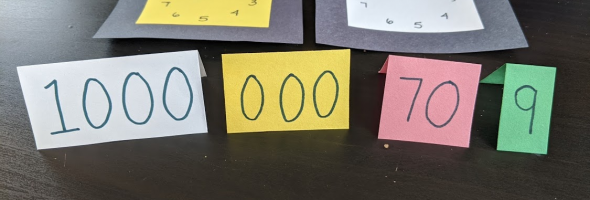Place Value Table Tents
Mitra Paysen
Introduction/Explanation:
Place Value Table tents are a great, interactive way to introduce the topic of place value, and have students practice the concept and deepen their understanding in a hands-on way. The flexibility within the activity, and the ability to continue adding higher digits (ie. Hundreds, Thousands, Ten Thousands) makes it a great tool for teachers to be able to use with a variety of students and grades.
Place value runs through the early years of the BC Curriculum1 in multiple grades’ Big Ideas:
- Kindergarten
- Numbers represent quantities that can be decomposed into smaller parts.
- Grade 1
- Numbers to 20 represent quantities that can be decomposed into 10s and 1s.
- Grade 2
- Numbers to 100 represent quantities that can be decomposed into 10s and 1s.
- Development of computational fluency in addition and subtraction with numbers to 100 requires an understanding of place value
- Grade 3
- Development of computational fluency in addition, subtraction, multiplication, and division of whole numbers requires flexible decomposing and composing.
This activity could therefore be tailored and used with grades K-3. However, due to the many components of the activity, I believe it would be best suited for grades 2-3. With having slightly more independence in these grades, the teacher can then ensure the students work together, giving more time for monitoring all students’ participation and completing formative assessment throughout the task.
It is important that students gain a good understanding of place value and base 10, so that their future math skills that build from these concepts do not suffer.
How It Works
Materials Needed:
- Place Value Tents (my home-made ones pictured below)
- Spinners or 0-9 dice (mock spinners pictured below)
- Base 10 blocks (1’s, 10’s, 100’s, 1000’s)
- Place value mat
Students have a set of ‘table tents’ ranging in 0-9 for 1’s – 1000’s (or higher – sky is the limit!). They may work independently or in groups, as suits the students best.

Each number group is colour coded to an accompanying spinner or set of die, and base 10 blocks with a building mat. Students then spin numbers 0-9 on each of their spinners or die, and build the standard form of the number out of the tents, and the expanded form out of blocks on their place value mat. The multimodal aspect of this place value activity allows students to gain a clearer understanding of the meaning behind the concept of place value.



Being that there are multiple components to this activity, it lends itself well to enabling students to work in groups to work through the concepts together. By allowing for a group dynamic, students are able to look to one another for help and guidance, rather than solely relying on the teacher for information.
Modifications or Extensions
With each student or group of students having their own set of tents, blocks, and spinners, the activity can easily be tailored to meet the varied needs of all students. If the idea of place value is just being introduced, the teacher could provide only 10’s and 1’s to the students to begin to gain an understanding of how place value works. If other students are mastering the 1000’s, the teacher could provide that student with the next level of 10000’s to begin to work through.
With the easily attainable variety within the activity, the teacher can assure that all students are working within their zone of proximal development, and no students are left to struggle and become defeated, or left bored and unchallenged.
Assessment

Photo-documentation & a teacher checklist are great forms of formative assessment for this activity. Although worksheets could also easily be integrated into the process, many students may lose motivation for continuing their learning of place value through this game should paper and pencil be involved.

With students working mainly in groups, the teacher has more freedom to be able to move around the classroom to observe all students, making observations on their checklist, as well as snap photos to be able to post to FreshGrade for their parents, as well as to have the students reflect on later as a form of self-assessment (ie. in their math notebooks).
References
Thank you to the Grade 3 class at Happy Valley Elementary for the initial inspiration for the activity.
- Province of British Columbia (July 2019). Math K-9 Big Ideas. Retrieved from: https://curriculum.gov.bc.ca/sites/curriculum.gov.bc.ca/files/curricul um/cntinuusviews/en_math_k-9_big_ideas.pdf
- Lakeshore Learning. Place Value Activity Kit. Retrieved from: https://www.lakeshorelearning.com/products/math/place-value/place value-activitykit/p/LC165/
- The Brown Bag Teacher (2015). Place Value: 1st Grade Centers. Retrieved from: https://brownbagteacher.com/place-value-1st-grade-centers/

